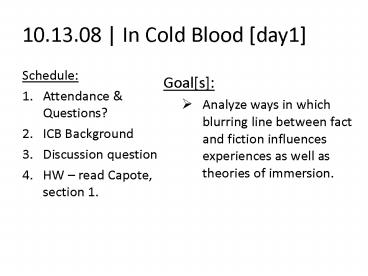10'13'08 In Cold Blood day1 - PowerPoint PPT Presentation
1 / 8
Title:
10'13'08 In Cold Blood day1
Description:
Based on the real life multiple homicide of the Clutter family of Holcomb, KS in 1959. ... He lived in Holcomb and meticulously researched the family, their community, ... – PowerPoint PPT presentation
Number of Views:66
Avg rating:3.0/5.0
Title: 10'13'08 In Cold Blood day1
1
10.13.08 In Cold Blood day1
- Schedule
- Attendance Questions?
- ICB Background
- Discussion question
- HW read Capote, section 1.
- Goals
- Analyze ways in which blurring line between fact
and fiction influences experiences as well as
theories of immersion.
2
Immersion recap.
- Metaphors of submersion or space travel require
two planes, two realities. - Native, actual reality of everyday life.
- The possible, textual reality supported by media.
- So far, its been pretty easy to maintain that
separation. - What happens, though, when the possible world is
based on fact?
3
In Cold Blood 1965
- Based on the real life multiple homicide of the
Clutter family of Holcomb, KS in 1959. - Capote read the 300-word news story in the NY
Times and decided it sounded like the foundation
for a great novel. - He lived in Holcomb and meticulously researched
the family, their community, their death, and
their killers. - Capote was assisted by his friend Harper Lee, who
had just published To Kill a Mockingbird.
- Holcomb, Kan., Nov. 15 1959 (UPI) -- A
wealthy wheat farmer, his wife and their two
young children were found shot to death today in
their home. They had been killed by shotgun
blasts at close range after being bound and
gagged ... There were no signs of a struggle, and
nothing had been stolen. The telephone lines had
been cut. The New York Times
4
New Journalism
- Began several years prior to the Clutters death
in the mid-late 50s, though took full force in
the 60s 70s. - Tom Wolfe described it as reporting as having an
esthetic dimension. - Research and fact based narratives using
novelistic conventions. - Many suspected, as Wolfe himself acknowledges,
The bastards are making it up! as people were
unaccustomed to the degree of access NJ authors
got. - the journalistic and literary old guards began
to attack this new journalism as
impressionistic despite the intense research
needed.
5
New Journalism research
- The most important things one attempted in terms
of technique depended upon a depth of information
that had never been demanded in newspaper work.
Only through the most searching forms of
reporting was it possible, in non-fiction, to use
whole scenes, extended dialogue, point-of-view,
and interior monologue. 21 - To get factual extended dialogue, point-of-view,
and interior monologue often NJ authors had to
immerse themselves in the lives of the
characters, actually be there when dramatic
scenes took place, to get the dialogue, the
gestures, the facial expressions, the details of
the environment 21. - Wolfe argues this produces a kind of aesthetic
work that benefits from the simple fact that the
reader knows all this actually happened Wolfe
34.
- The kind of reporting they were doing struck
them as far more ambitious, too. It was more
intense, more detailed, and certainly more time
consuming than anything newspaper or magazine
reporters, including investigative reporters were
accustomed to 21.
6
Capotes non-fiction novel
- Capote did not identify himself with the NJs,
largely because he saw himself as a novelist
doing research rather than a journalist doing
novel-style. He coined the term non-fiction
novel to describe ICB. - Capote researched for 6 years, lived with the
chief of police, and conducted thousands of
interviews. - He trained himself to memorize conversations in
order to have more intimate interactions. - The book begins with an Acknowledgements
section stating All the material in this book
not derived from my own observation is either
taken from official records or is the result of
interviews with the persons directly concerned,
more often than not numerous interviews were
conducted over a period of time. - In interviews, Capote insisted that his work,
while representing only one perspective on what
happened, his, it was 100 factually-based.
7
- Fact vs. narrative
- Truth vs. aesthetics
- Reporting vs. style
- Objectivity vs. subjectivity
- Authors presence, authors task, authors
involvement. - readers presence, readers task, readers
involvement. - Empathy, sympathy, morality
- Knowledge production, investigations, trials.
- Character? Plot? Setting? Themes? Can we talk
about them the same way?
- Does knowing the background of this story affect
the way we read it?
8
Todays discussion
- Capote dedicates a rather lengthy portion of the
book to describe characters who we know before
hand will be dead or far away from Holcomb. - Did you find that these descriptions of the
Clutters and of Perry and Dick were something
that you cared about? - Why do you think that Capote describes these
characters in the beginning rather than build
them up throughout the investigation?































